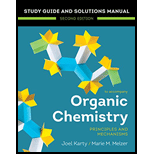
(a)
Interpretation:
Whether an E2 elimination from the given
Concept introduction:
E2 elimination is a single step mechanism involving both the substrate molecule and the reagent molecule. It involves the elimination of a leaving group along with hydrogen from a carbon adjacent to the one with the leaving group. In E2 mechanism, a strong base extracts the proton with the
(b)
Interpretation:
Whether an E1 elimination reaction, from the given precursor, will produce a pure stereoisomer or a mixture is to be determined.
Concept introduction:
E1 elimination is a two-step reaction. The leaving group breaks off in the first step taking its bond pair with it. A trigonal planar carbocation results from this step. Since the carbocation is planar, any one of the hydrogen atoms, on an adjacent carbon, can be removed as a proton. The associated
(c)
Interpretation:
In each of the two reactions that produce a mixture, which isomer is produced in greater abundance is to be determined.
Concept introduction:
When a reaction produces a mixture of stereoisomers, the product distribution depends on two factors, the stability of the product and the stability of the conformers of the precursor in case of an E2 reaction. An E2 reaction requires that the proton and the leaving group be anti to each other. If there are two protons on the beta carbon, the relative stabilities of the two conformers will influence the product distribution.
Want to see the full answer?
Check out a sample textbook solution
Chapter 8 Solutions
EBK ORGANIC CHEMISTRY: PRINCIPLES AND M
- Following is the structure of miconazole, the active antifungal agent in a number of over-the-counter preparations, including Monistat, that are used to treat vaginal yeast infections. One of the compounds needed for the synthesis of miconazole is the trichloro derivative of toluene shown on its right. (a) Show how this derivative can be synthesized from toluene. (b) How many stereoisomers are possible for miconazole?arrow_forwardThe bicyclic heterocycles quinoline and indole undergo electrophilic aromatic substitution to give the products shown. (a) Explain why electrophilic substitution occurs on the ring without the N atom for quinoline, but occurs on the ring with the N atom in indole. (b) Explain why electrophilic substitution occurs more readily at C8 than C7 in quinoline. (c) Explain whyelectrophilic substitution occurs more readily at C3 rather than C2 of indole.arrow_forwardWhen treated with NaOH, the bromide below gives an alkene by the E2 mechanism, by eliminationof the circled atoms: (a) Draw the Newman projection from which elimination takes place. (b) Draw the mechanism. (c) Draw the product with the proper stereochemistry. (d) Assign the proper stereochemical descriptor to the product. (Z, E? Trans,CiS?) (e)What would happen to the stereochemistry of the product if the enantiomer of the starting material were used inthe reaction?arrow_forward
- gas, Cl¬CH2CH2¬S¬CH2CH2¬Cl, was used as a poisonous chemical agentin World War I. Mustard gas is much more toxic than a typical primary alkyl chloride. Itstoxicity stems from its ability to alkylate amino groups on important metabolic enzymes,rendering the enzymes inactive.(a) Propose a mechanism to explain why mustard gas is an exceptionally potent alkylatingagent.(b) Bleach (sodium hypochlorite, NaOCl, a strong oxidizing agent) neutralizes and inactivates mustard gas. Bleach is also effective on organic stains because it oxidizes coloredcompounds to colorless compounds. Propose products that might be formed by thereaction of mustard gas with bleach.arrow_forwardDraw the structures of compounds A and B in the scheme below. Be sure to indicate the stereochemistry. E2 Ph Elarrow_forwardElectrophilic aromatic substitution usually occurs at the 1-position of naphthalene, also called the a position. Predict themajor products of the reactions of naphthalene with the following reagents.(a) HNO3, H2SO4arrow_forward
- Rank the compounds in each group in order of increasing reactivity in electrophilic aromatic substitution: (a) C6H6, C6H5Cl, C6H5CHO, C6H5OCH3; (b) C6H5CH3, C6H5NH2, C6H5CH2NH2, C6H5CONH2.arrow_forward(E)-Anethole is the major component of anise oil, which is used as artificial licorice flavoring and has potential antimicrobial and antifungal properties. It can be synthesized from an alkyl halide precursor, as shown here. Br E2 or E1 (E)-Anethole (a) Will an E2 reaction produce (E)-anethole exclusively, or will the reaction produce a mixture of stereoisomers? (b) Will an E1 reaction produce the pure stereoisomer or a mixture? (c) For each of these reactions that produces a mixture, which stereoisomer will be produced in greater abundance?arrow_forwardThe bicyclic heterocycles quinoline and indole undergo electrophilic aromatic substitution to give the products shown. (a) Explain why electrophilic substitution occurs on the ring without the N atom for quinoline, but occurs on the ring with the N atom in indole. (b) Explain why electrophilic substitution occurs more readily at C8 than C7 in quinoline. (c) Explain why electrophilic substitution occurs more readily at C3 rather than C2 of indole.arrow_forward
- Given that an E2 reaction proceeds with anti periplanar stereochemistry, draw the products of each elimination. The alkyl halides in (a) and (b) are diastereomers of each other. How are the products of these two reactions related? Recall from Section 3.2A that C6H5 −is a phenyl group, a benzene ring bonded to another group.arrow_forwardMustard gas, Cl¬CH2CH2¬S¬CH2CH2¬Cl, was used as a poisonous chemical agentin World War I. Mustard gas is much more toxic than a typical primary alkyl chloride. Itstoxicity stems from its ability to alkylate amino groups on important metabolic enzymes,rendering the enzymes inactive.(a) Propose a mechanism to explain why mustard gas is an exceptionally potent alkylatingagentarrow_forwardFor each reaction, give the expected substitution product, and predict whether the mechanism will be predominantly first order (SN1) or second-order (SN2). (a) isobutyl bromide + sodium methoxidearrow_forward
 Organic ChemistryChemistryISBN:9781305580350Author:William H. Brown, Brent L. Iverson, Eric Anslyn, Christopher S. FootePublisher:Cengage Learning
Organic ChemistryChemistryISBN:9781305580350Author:William H. Brown, Brent L. Iverson, Eric Anslyn, Christopher S. FootePublisher:Cengage Learning
